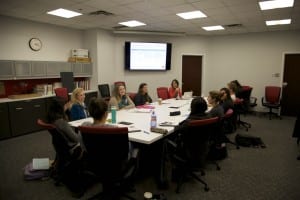TAI Professor Eunjin (Anna) Kim recently had a research paper accepted in another academic journal for her research titled “Why Narrative Ads Work: An Integrated Process Explanation.” To date, Professor Kim has been published in eight academic journals, with another publication forthcoming. She has always been interested in narrative persuasion and persuasion knowledge.
Her most recent accepted publication about narrative advertising will be in the Journal of Advertising. She was motivated to start this research to create a more integrated framework to decipher what makes storytelling and narrative more effective.
“In previous studies, experiments used fake advertisements where consumers would watch and then judge [them],” Professor Kim said. “Most of storytelling advertising is in a video format. If you have to create the stimuli [ad] then it will be artificial. I tested with real TV commercials that aired on CBS over a two-week period from 5:30pm-11:30pm (2/20/2015-3/6/2015). Out of the 312 unique commercials aired, those ads were drawn into a random sample of 25 narrative and 25 non-narrative commercials. Four hundred and eighty-four participants were recruited from an online panel system; each participant was randomly assigned into either a narrative condition or non-narrative condition, watched a single commercial, and then answered a set of questions. I evaluated the responses for each category, comparing the two groups to see how storytelling [commercials] performed compared to non-storytelling commercials among criteria I created.”
This research means a lot to Professor Kim, as it started as her doctoral dissertation. She considers publication in the Journal of Advertising as one of her greatest career accomplishments to this point.
“It is a big accomplishment since Journal of Advertising is the top advertising journal, with an 8-9% acceptance rate,” Professor Kim said. “This paper is one of my dissertation studies that I won a doctoral dissertation proposal award from American Academy of Advertising in 2014. Narrative persuasion is one of the major research areas that I am focusing on. I want to build my reputation on the topic of narrative advertising. So, I say it was a very good start. My first narrative advertising study in the top advertising journal.”
Professor Kim teaches four courses at both the undergraduate and graduate level throughout the year, including Digital Media Strategy 1, Strategic Brand Management, Media Measurement and Metrics, and Theories of Persuasion. Since she started teaching at SMU last fall, Professor Kim has had to learn how to balance both her teaching and research responsibilities effectively.
“Balancing the two is not easy as a junior faculty [member],” Professor Kim said. “I try to set [aside] a time for research only. For example, I focus on teaching from Monday to Thursday and then try to work on research from Friday to Sunday. I teach four different classes per year, two per semester. Since three of them are newly created courses, it takes more time for me to prepare them. The other one is a graduate class. This was not a new course, but it was new to me since I started to teach the course last fall for the first time. Hopefully, next semester I can spend more time on research.”
Through her many years of research, Professor Kim has learned and gained a lot from her various research endeavors. Aside from theoretical and statistical methods and trainings, she considers patience and endless curiosity to be her biggest gains.
“Research is not a simple process,” Professor Kim said. “It takes long time to publish one paper. Conducting a research, including ideation, takes at least a year. Often times it takes more than a year if your data don’t cooperate. Once you conduct research, writing a research paper takes about six months depending on your time availability. Then you submit a paper. The review process takes about a year [sometimes longer]. After you submit a paper, authors usually go through 2-3 revisions until they publish. Now you can see why I have to be patient. [And] one research is not the end of the research on a specific topic. Usually, research at my hands inspires me a lot and makes me curious about why people behave in a certain way and why and how they arrive a certain choice. So over the years of research experience, I’ve got lots of research questions that I want to pursue. I create research idea documents and saved [them] in a folder labeled ‘Research ADD’ on my computer. There are so many interesting phenomena and research questions that I want to explore/solve. Believe or not, sometimes I can’t sleep because I can’t stop thinking about them.”
Because of this endless curiosity, Professor Kim will have many future research projects ahead of her. Her next project is a subsequent study about why some narrative ads are more effective than others. She is hopeful that the next paper will also be accepted by the Journal of Advertising.
“As we know, not all stories are equally interesting and fun,” Professor Kim said. “Likewise, not all storytelling ads are equally effective. For example, a story in an ad itself might not be interesting and attention capturing. Even if a story is very good (e.g., fun, interesting, moving, etc.), if the ad contains no brand information, the ad is not effective in terms of branding. If an ad contains too much brand information and the information is not well integrated into a story, this will interfere with the story flow and viewers would get easily get annoyed, thereby developing negative responses to the ad and the brand. Another case could be a situation where consumers cannot relate the ad or brand with themselves. Let’s say an ad story is very interesting/entertaining and brand information is well integrated in the ad. As an advertiser, you feel like you couldn’t do any better than this. You would expect very positive responses from target consumers; however, things could turn out badly if consumers cannot relate themselves with ad characters, situations, and/or advertised product or brand. Ad relevance is another big factor contributing to the effectiveness of narrative advertising.”



